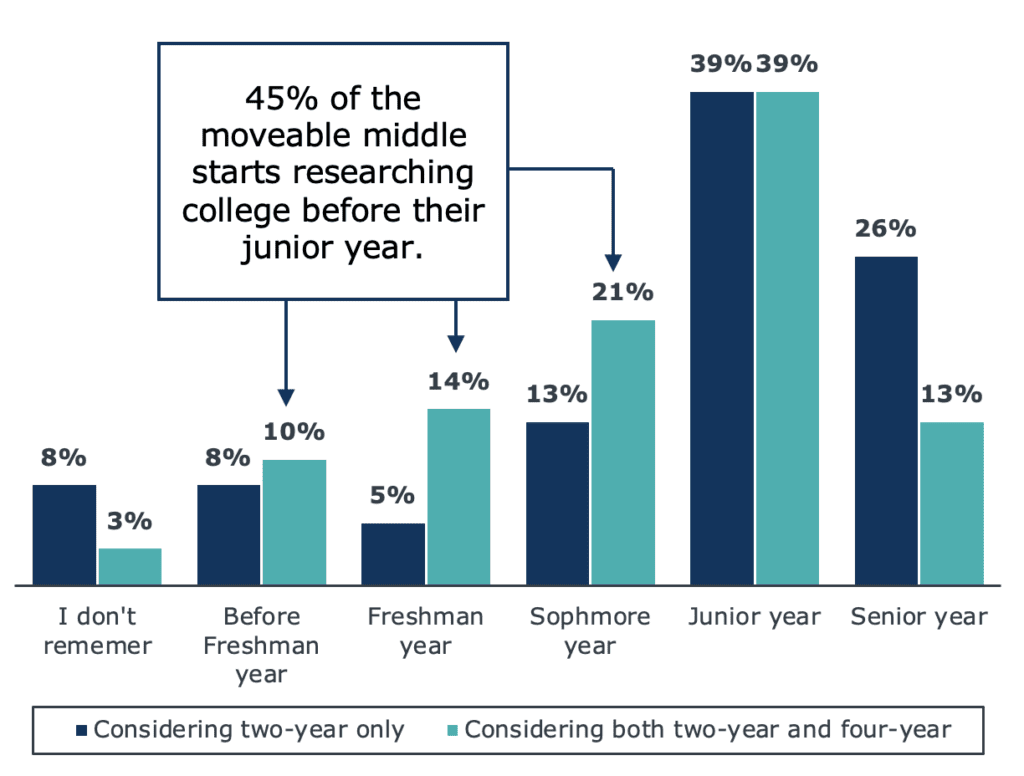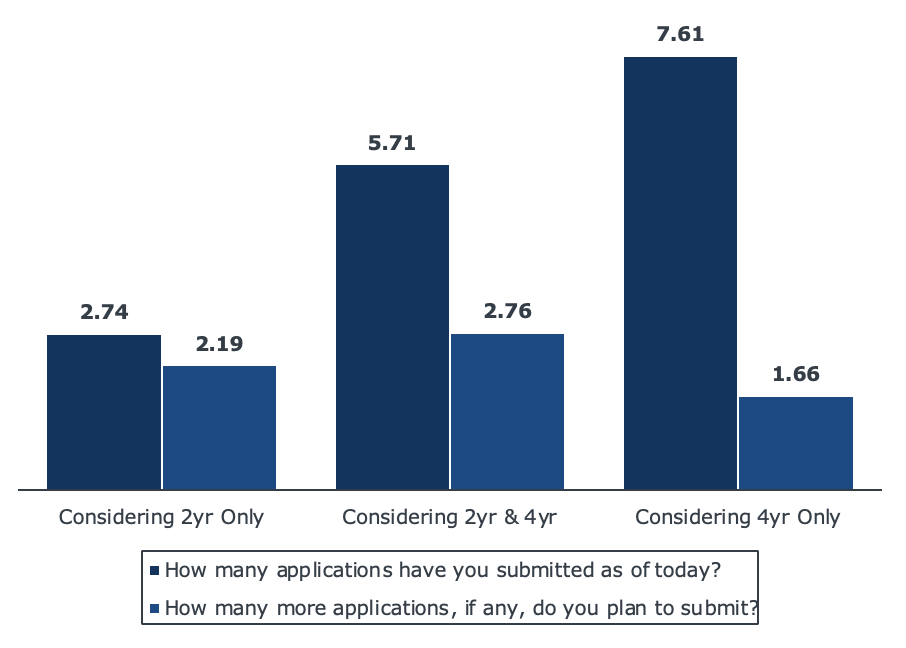Four tips to engage and enroll the “moveable middle”
What we know about prospective students weighing both four-year and community college options
March 13, 2024, By Tara Zirkel, Director, Strategic Research
When I worked in community college admissions, I spent a lot of time interacting with high school students. Generally, there were three types of students: a few who were already set on your college, some that were set on a four-year college, and a group we liked to call the “moveable middle:” those weighing the benefits of a four-year college compared to a two-year college.
-
What is the “moveable middle?”
Students who are deciding between attending a four-year college or community college, who might be a strong match for a two-year institution.
The students in the third group often have different concerns, drivers, and college search habits than those who’ve already chosen between two-year and four-year. They’re comparison shoppers—students who are exploring multiple colleges and scoring them based on price, programs, flexibility, and how they think the institution will contribute to them climbing the economic ladder. Ultimately, we want every student to choose the college that’s right for them—whether it’s a community college, four-year option, or short-term training—and, for many students, community colleges can be that “right fit” choice.
In this blog, I’ll share four insights from our new insight paper and tips to help you identify, engage, and enroll this crucial demographic.
Insight 1: The moveable middle starts their college search earlier than students who are settled on attending community college.
Compared to students who are only considering two-year options, students considering both two-year and four-year colleges start their college search much earlier. Of students considering both options, 45% have started their research by the end of the start of their junior year, compared to 27% of students only considering community college.
When did you begin researching college options?

Community colleges need to play the long game to effectively recruit younger learners. To connect with these savvy searchers, community colleges need to begin outreach efforts prior to junior year. This might mean creating targeted recruitment events, open houses, and collateral geared toward high school freshman and sophomores.
This could also look like collecting information about prospective students earlier and having contact with students for potentially years—not just weeks or months—to build meaningful rapport. Often, admissions offices focus on inquiries and applicants who are interested in the next semester, leaving students interested in future semesters with limited engagement. Having a plan for all the prospects in your pipeline, including younger dual-enrolled students, is a way to be competitive for students who start their search early in their high school career.
Insight 2: The moveable middle is made up of more active “shoppers” than students only interested in community colleges.
Not only are students who are on the fence researching earlier, they are using more resources to conduct their search. Across the board, students considering both options are more engaged with a college support system (like counselors, teachers, and family members), written materials, and online college research tools than students who’ve already settled on a two-year pathway.
Consider the list below and select each source you have used during your college search.
Participants Could Select All That Apply

An interesting point, and a place where two-year colleges stand to improve, is that only 17% of students considering two-year colleges cited using “personal letters from colleges” as a college search source compared to 41% of students considering both. This could mean that students considering both are receiving personalized letters from four-year colleges, but not necessarily from two-year colleges— signaling a missed opportunity to enhance recruitment.
Students considering both college options are also more likely to use web searches (51% v 35%) and online college search sites (41% v 26%) which points to the importance of community colleges making sure their web presence is strong, user-friendly, and competitive against four-year websites.
-
Web and Mobile Presence Audits
In response to community colleges’ growing interest in optimizing their digital footprint, EAB developed audits to evaluate partners’ unit websites and program landing pages.
How many applications have you submitted as of today? How many more, if any, do you plan to submit?
Mean applications submitted, asked of seniors

Knowing that the moveable middle is likely comparing multiple acceptance opportunities and is highly engaged means community colleges must have a continuous outreach plan and excellent customer service. Technology, such as Navigate360, can make it easier to coordinate and scale communications, and can empower frontline staff with the answers they need as students “shop” your college.
LEARN HOW CUSTOMER SERVICE INTERACTIONS CAN MAKE OR BREAK STUDENT MOMENTUM
Insight 3: The moveable middle is more concerned about cost than other groups.
We weren’t surprised to see students considering two-year colleges were concerned about affordability; but what was surprising was that students considering both two-year and four-year options were actually more financially sensitive than students only considering two-year. This might mean students are shopping multiple colleges and comparing their aid and scholarship awards to see which school can give them the best “deal.”
When you think about college costs and what you get for the price you pay, what characteristics would you say best represent the value of education?
Participants Could Select Up to Five Responses, Top Five Answers Are Shown

What this means for two-year leaders, aside from marketing the attractive price point of two-year schools, is that financial aid packages and scholarship awards need to be provided as early as possible so students can compare them against offers from other colleges. Often, the community college aid package will be the most cost effective, but students may not realize that if packages from other colleges are coming to them first.
Packaging financial aid awards and scholarships can be extremely time consuming, and even more complicated when students are selected for verification or have incomplete paperwork. Using technology to nudge students along their FAFSA journey can not only help students submit materials faster, but it can also help free up financial aid professionals’ time to work 1:1 with students who need additional support.
LEARN THREE STRATEGIES TO SUPPORT COMMUNITY COLLEGE STUDENTS’ FINANCIAL WELLNESS
Insight 4: The moveable middle is transfer motivated.
Overwhelmingly, students who are open to both two and four-year options want to earn a bachelor’s degree or higher as their end goal. This is good news, given that a core value proposition of community colleges is the opportunity to transfer to a four-year college as a way to save money and build a strong academic base. It’s also not surprising, given that upward transfer is seeing a resurgence, with almost an 8% increase in fall 2023.
Why are you considering a two-year college?
Participants Could Select All That Apply

It’s important that transfer students are academically on track, matched with a right-fit destination college, and don’t miss any milestones in the transfer process. One missed course, a low GPA, or a missed admissions deadline can completely derail a student’s transfer plan. These missteps not only negatively impact our students, they also contribute to a lurking public distrust of the community college to four-year college pipeline.
Holistically supporting students is easier said than done, and requires intentional coordination between students, advisors, faculty, and transfer specialists. At EAB, we recommend adopting a coordinated care approach where all members of a student’s “care team,” including advisors and faculty, use shared information to keep students on track.
This might include leveraging technology, like Navigate360, to create student journeys that guide students through important academic and non-academic milestones, such as researching transfer colleges, attending transfer fairs, or applying for admission. Navigate360 can also be used to create early alerts for students who are struggling or to monitor GPAs—both of which are critical for students who want to pursue a bachelor’s degree.
HOW ONE COLLEGE ACHIEVED A 78% FALL TO SPRING PERSISTENCE RATE WITH A COORDINATED CARE NETWORK
Don’t wait to connect with your moveable middle
Many students that make up the moveable middle could be best served by community colleges, so institutions need to understand what their goals are in order to craft pathways and supports that are specific for their needs. Technology like Navigate360 allows us to communicate with students throughout their entire journey at the college, from inquiry to graduation, lessening the likelihood that students will slip between the cracks.
Learn more about Navigate360
Discover how you can recruit, retain, and empower students in college and beyond.

More Blogs

Four ways community colleges can improve career readiness

Boost student engagement with data and easy-to-use technology
